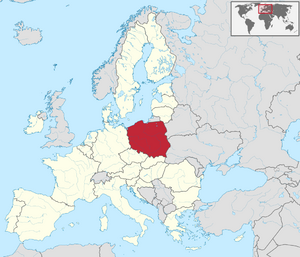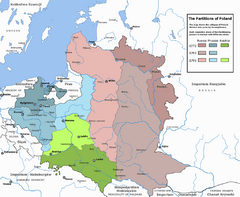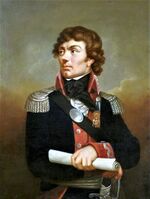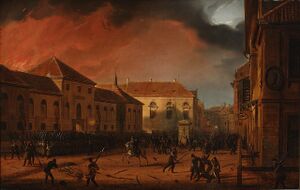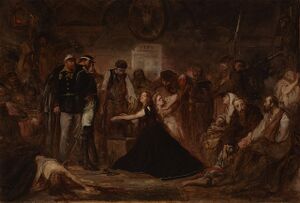User:Inkmne/sandbox
POLAND ARTICLE SANDBOX
| Republic of Poland Rzeczpospolita Polska | |
|---|---|
Map of Republic of Poland
| |

|

|
| Flag | State Emblem |
| Part of a series on |
| Former socialist states |
|---|
| List of states |
|
Albania · Bulgaria · Czech Republic · Slovakia · Germany · Hungary · Mongolia · Poland · Romania · Former Soviet Union (Armenia · Azerbaijan · Belarus · Estonia · Georgia · Kazakhstan · Kyrgyzstan · Latvia · Lithuania · Moldova · Russia · Tajikistan · Turkmenistan · Ukraine · Uzbekistan) |
| Politics |
| Opinions of socialism · Reactionism (Eurasianism · National Bolshevism · Religion · Decommunization · Banderism) · Western influence (NATO expansion · Color revolutions) |
| Issues |
| Demographic crisis · Economic issues · Poverty · Post-Soviet conflicts |
Poland (Polish: Polska [ˈpɔlska]), officially the Republic of Poland, is a capitalist state in Central Europe. It has a population of over 38 million and is the fifth most populous member state of the European Union. Warsaw is the nation's capital and largest metropolis.[1]
The country has a rich history of Marxist thought. It's the home of revolutionary Rosa Luxemburg, economist Michał Kalecki and philosopher Leszek Kołakowski, known for his critical analyses of Marxism. Poles were among the founding members of the First International.[2]
Poland is a founding member state of the United Nations, as well as a member of the World Trade Organisation, OECD, NATO and the European Union (including the Schengen Area). It has the sixth largest economy in the EU by GDP (nominal) and the fifth largest by GDP (PPP). It hasn't hde an ambassador in Israel since August 202,1 and its once-close diplomatic relations with Hungary worsened due to the Fidesz government's response to the 2023 Invasion of Ukraine.[3][4]
Modern History
Really? That's it? This section does not include the history of Poland from before the 16th century and by no means implies that its history began later than around 966. This section is meant to portray the context necessary to understand modern Polish culture. |
Polish Lithuanian-Commonwealth (1569-1795)
Population and Economy
The Union of Lublin of 1569 established the Polish-Lithuanian Commonwealth, a unified federal state with an elective monarchy but largely governed by the nobility. Its multicultural and relatively tolerant society was unique in Europe, becoming home to a diverse population of Poles, Lithuanians, Ruthenians, Germans, Jews, Dutch settlers (Olędrzy), and Scots.[5] The economy was dominated by the agricultural sector, mostly comprised of a type of noble-run large enterprise, called a folwark. Serfdom benefited the nobility as the dominant class and was never abolished during the Commonwealth. Due to its large exports of grain, Poland was often called "The Granary of Europe" (Polish: Spichlerz Europy).
Urbanisation within the Commonwealth presented a distinctive profile compared to Western Europe. Estimates of the Commonwealth's urban population vary greatly, from 20% to as low as 4-8%.[6][7] The preeminence of agrarian pursuits, coupled with the privileged status of the nobility vis-à-vis the bourgeoisie, impeded swift urban development and industrial expansion. The regulation of grain prices by the nobility served as a mechanism for wealth accumulation, epitomized by the prominence of trade fairs.
Political System
The political system of the Commonwealth included a unique amalgamation of distinctive, unique features. Rooted in the concept of Golden Liberty, the country's political system is difficult to compare with its contemporaries, but it can be tentatively described as a mixture of:
- federation, with regard to the broad autonomy of its regions. It is, however, difficult to decisively call the Commonwealth either confederation or federation, as it had some qualities of both;
- oligarchy, as only the szlachta (nobility)—around 15% of the population—had political rights;[8]
- democracy, since all the szlachta were equal in rights and privileges, and the Sejm could veto the king on important matters, including legislation (the adoption of new laws), foreign affairs, declaration of war, and taxation (changes of existing taxes or the levying of new ones). Also, the 15% of the Commonwealth population who enjoyed those political rights (the szlachta) was a substantially larger percentage than in majority European countries even in the nineteenth century; note that in 1820 in France, only about 1.5% of the male adult population had the right to vote, and in 1840 in Belgium, only about 5%.[9][10]
- elective monarchy, since the monarch, elected by the szlachta, was Head of State;
- constitutional monarchy, since the monarch was bound by pacta conventa and other laws, and the szlachta could disobey any king's decrees they deemed illegal.
Partitions
The extent of the liberties granted to the nobility later started to backfire as the Commonwealth's influence waned. Russia began to exert influence over Poland with the election of King Stanisław II August. This resulted in the 3 May Constitution, which was groundbreaking for its time, being the second ratified constitution in history. It brought about many much-needed reforms, including the abolition of the liberum veto, the establishment of the separation of powers, the expansion of political rights to include the bourgeoisie as well as the nobility, and the strengthening of the rights of the peasantry. Despite these measures, the Commonwealth was soon forced to partition and completely cede its territory to its neighbours—Russia, Prussia, and Austria.
Uprisings and World War I (1794-1918)
The Kościuszko Uprising
In 1794, Tadeusz Kościuszko, a distinguished general in the American Revolutionary War, led an insurrection against Russian and Prussian influence in the Commonwealth. Through a proclamation in Kraków’s town square, he issued a nationwide uprising against the bordering imperialist powers, who neiglargelyly infiltrated Polish politics in an attempt to weaken and ultimately subjugate it. Despite a major victory at the Battle of Racławice, the ultimate failure of the insurrection sealed Poland’s fate for the next 123 years.
Napoleonic Wars
In 1806, an insurrection organised by Jan Henryk Dąbrowski liberated western Poland ahead of Napoleon’s advance into Prussia during the War of the Fourth Coalition. The Duchy of Warsaw was proclaimed the next year in the Treaty of Tilsit. The Poles actively aided French troops in the Napoleonic Wars, particularly those under Prince Józef Poniatowski. In the aftermath of Napoleon's exile, the Duchy of Warsaw was abolished at the Congress of Vienna in 1815 and its territory was divided into Russian Congress Kingdom of Poland, the Prussian Grand Duchy of Posen, and Austrian Galicia with the Free City of Kraków.
The November Uprising
Initially, Congress Poland enjoyed a relatively large amount of internal autonomy. It had its own constitution and parliament. Over time, however, the freedoms granted to the Kingdom were gradually taken back, and the constitution was largely ignored by the Russians. Alexander I of Russia never formally crowned himself King of Poland, instead appointing his brother as de facto viceroy in 1815.
In November 1830, a Russian plan to use the Polish Army to suppress France's July Revolution and the Belgian Revolution was leaked, inducing upheaval among the Poles. On November 29, 1830, the armed struggle began when a group of conspirators led by Piotr Wysocki took arms from their garrison and attacked Belweder Palace, the main seat of the Grand Duke. Though the insurgents initially demonstrated resilience, they were quickly met with internal divisions and a lack of external support. By September 1831, Russian forces had recaptured Warsaw, resulting in Polish capitulation.
In 1832, the Tsar issued the Organic Statute, according to which Congress Poland would lose its autonomy and become an integral part of the Russian Empire. Warsaw became little more than a military garrison, and its university closed.
After the uprising, Poles wore black ribbons and jewellery as a symbol of mourning for their lost homeland. Many of Poland's intelligentsia later migrated west to avoid prosecution in what became known as the Great Emigration.
Germanisation
King Frederick the Great notably despised Poles. While the Kingdom of Prussia already possessed a large Polish population in Upper Silesia, it gained additional Polish citizens during the partitions of Poland. As such, from the beginning of Prussian rule, Poles were subject to systematic erasure of their language, culture, and heritage as a blatant attempt at colonisation. Polish was replaced by German as the official language, and the people were portrayed as 'backward Slavs'. By the 1840s, they were subjected to colonisation attempts by the Prussians, as about 60% of the population of the Duchy was Polish, 34% was German, and 6% was Jewish.[11] Furthermore, in 149–172 out of the administrative districts, Poles had a majority in 18 while Germans in 6, out of which 4 were in the western part and 2 in the northern part.[12] The base support of Prussian rule came from an influx of German colonists, whose immigration started as soon as 1772 as a planned systemic action of the Prussian government. The Prussians knew exactly that after the partitions, Poles mainly aspired for independence. Soon, two methods of subduing Polish resistance began to be considered. One pushed for winning over the Polish nobility and diverting them from the Russians, while the other pushed for the systematic, ruthless Germanization of the Poles. Though initially the former prevailed, the primary Prussian method of subjugation eventually turned to the latter.
In 1819, the gradual elimination of the Polish language in schools began, with German being introduced in its place. Poles’ already poor situation took a turn for the worse when in 1825, August Jacob, a politician hostile to Poles, gained power over the newly created Provincial Educational Collegium in Poznań. Across the territories, Polish teachers were being removed from work, and German educational programmes were being introduced.
Nevertheless, Poles continued to ask for Polish representation in the administration of the area, representing the separate character of the Duchy and doing their best to preserve the Polish character of schools. From 1825 on, the increase in anti-Polish policies became more visible and intense. Prussian political circles demanded an end to tolerance for Polishness. Among the Poles, two groups emerged, one still hoping for respect of the separate status of the Duchy and insisting on working with Prussian authorities, hoping that in time they would grant some freedoms. The other faction still actively advocated for an independent Poland.
As the November Uprising in Russian-held Congress Poland began, the Prussians closely worked with Russia in regards to stopping any Polish independence drive. In 1830, Eduard Heinrich von Flotwell assumed control of the region, advocating for Germanization and asserting the superiority of German culture. With the support of prominent figures such as Carl von Clausewitz and Wilhelm von Humboldt, he endorsed a programme that marginalised Poles from offices and administration, leading to a decline in their representation and rights. By 1830, for example, the right to use Polish in courts and institutions was no longer respected.[13] While the Poles constituted the majority of the population in the area, they held only 4 out of 21 official high-level posts.[13] From 1832 on, they could no longer hold higher posts at the Landrat.[13]
The Spring of Nations and the Greater Poland Uprising
A first attempt to change the situation in the Duchy was made in the Uprising of 1846, after which 254 Polish activists were imprisoned on charges of conspiracy. The sentences were not carried out, however, as the March Revolution began in 1848 and the King pardoned the prisoners as part of the concessions. Soon, the Polish National Committee was created as Poles began to organise a militia. By April, rebels were waging minor battles across the Grand Duchy. In exchange for promises of autonomy, the Committee agreed to dissolve some of its units and signed an agreement in Jarosławiec on April 11. However, the Prussians had no intention of honouring their promise, and they set about completely dismantling the militia. In response, the existing forces resumed fighting but quickly lost cohesion. The Polish capitulation was signed on May 9th, 1848.
The January Uprising
A confluence of factors rendered the uprising inevitable in early 1863. Older Poles longed for the semi-autonomous status of Congress Poland, and the youth were encouraged by the success of the Italian independence movement. Furthermore, Russia had been weakened by the Crimean War and had introduced a more liberal attitude in its internal politics, which encouraged Poland's National Government to plan an organised strike against their Russian occupiers no earlier than the spring of 1863. In an attempt to derail their aspirations, the governor brought forward to January the conscription into the Imperial Russian Army for 20-year service.
The rebellion was soon joined by high-ranking Polish-Lithuanian officers and members of the gentry. The insurrectionists were severely outnumbered, lacking sufficient foreign support and forced into hazardous guerrilla tactics. Reprisals for engaging in revolutionary activity were swift and ruthless. Public executions and deportations to Siberia eventually persuaded many Poles to abandon the armed struggle. In addition, the sudden decision to abolish serfdom in 1864 broke up many of the estates and severely damaged the cause’s popularity among the peasantry. The last leader of the Uprising, Romuald Traugutt was taken into custody with the last four members of the National Council on the night of April 10th. Apprehended by Russian troops, they were imprisoned and executed by hanging on August 5th 1864 at the Warsaw Citadel, marking the symbolic end of the Uprising. Its fall prompted severe political, social and cultural reprisals, followed by deportations and pogroms oft the Polish-Jewish population. It was the longest-lasting insurgency in partitioned Poland.
References
- ↑ "Poland country profile". BBC News. Retrieved 14-12-2023.
- ↑ Documents of the First International. The General Council of the First International, 1864-1866. The London Conference 1865. Minutes. Foreign Languages Publishing House. Moscow. 1964, p. 1
- ↑ Rigamonti, Magdalena. "Polska nadal bez ambasadora w Izraelu. Minister Sikorski: Braun nie będzie dyktował mi co mam robić". Onet. Retrieved 14-12-23.
- ↑ Tilles, Daniel (2022-07-30). ""The paths of Poland and Hungary have diverged," says Polish PM. Notes From Poland. Retrieved 2023-14-12.
- ↑ Kopczyński, Michał; Tygielski, Wojciech (2010). Pod wspólnym niebem. Narody dawnej Rzeczypospolitej (in Polish). Warszawa: Bellona.
- ↑ Institute of History (Polish Academy of Sciences) (1991). "Volumes 63–66". Acta Poloniae historica. National Ossoliński Institute. p. 42.
- ↑ Allen, Robert. "Economic Structure and agricultural productivity in Europe, 1300–1800" in: European Review of Economic History, 3, 1-25. Cambridge University Press. 2000. p. 8
- ↑ Aleksander Gella, Development of Class Structure in Eastern Europe: Poland and Her Southern Neighbors, SUNY Press, 1998, p. 13
- ↑ David Sneath (2007). The headless state: aristocratic orders, kinship society, & misrepresentations of nomadic inner Asia. Columbia University Press. p. 188.
- ↑ M. L. Bush (1988). Rich noble, poor noble. Manchester University Press ND. pp. 8–9.
- ↑ Makowski, Krzysztof (1996). Munich 1996 (ed.). Das Großherzogtum Posen im Revolutionsjahr 1848/49 (in German). Oldenbourg. ISBN 9783486560121.
- ↑ Jerzy Zdrada - Historia Polski 1795-1918 Warsaw, Wydawnictwo Naukowe PWN 2007; pages 268, 273-291, 359-370.
- ↑ 13.0 13.1 13.2 Andrzej Chwalba - Historia Polski 1795-1918. Wydawnictwo Literackie. Kraków, 2000.
